WHAT IS A KOREAN DRY SAUNA?
If you ever thought Korean dry saunas were just another form of steam room or hot tub, think again! Korean dry saunas, also known as "hanjeungmak" or "jjimjilbangs," are a unique cultural and wellness experience that offers more than just a soothing escape.
Originating from the land of kimchi and K-pop, Korean dry saunas offer several health benefits, from improved detoxification, relaxation, and circulation to a boosted immune system.
The question is, what is a Korean dry sauna? How do these saunas differ from conventional steam rooms? How can you get the most out of your next visit?
Read on to learn everything about Korean dry saunas and learn about some little-known tips to make your sauna experience nothing short of unforgettable!
What is a Korean Dry Sauna and How Does It Work?
Korean dry saunas are commonly found in Korean spa centers. These jimjilbangs offer several facilities, including refreshing hot and cold pools, relaxing massage rooms, comfy heated sleeping areas, and communal spaces where friends and family can gather, unwind, and de-stress.
However, a Korean dry sauna's main attraction is the sauna itself. It typically consists of a large room with wooden benches and heated stones set against a backdrop of traditional Korean paintings. The stone or clay kilns are usually heated between 122 to 140 degrees Fahrenheit.
Unlike their Western counterparts, or traditional dry saunas, Korean dry saunas are often not as intensely hot but are designed for a longer, more relaxing sauna experience. In a Korean dry sauna, you usually lie down or sit on mats crafted from bamboo or hemp.
If you're feeling particularly adventurous, consider opting for a professional scrub called "seshin." Conducted by skilled "ajummas" (middle-aged women), you can use this opportunity to scrub off all the dirt and dead skin cells from your body.
After your invigorating sweat session, you can cap off with a cold, sweet cup of "sikhye"— an energizing Korean drink made of malt and rice to help quench your post-sauna thirst and replenish lost fluids.
The best part? The entry fee for a Korean dry sauna is generally 7,000 to 12,000 won (or about five to 10 American dollars), which is quite a bargain, especially considering that you can spend hours at the spa and still have plenty of time left to enjoy the facilities.
For an extra 10,000 to 15,000 won, you can tuck in for the night in a Korean bathhouse. These facilities come with communal sleeping areas, where you are provided with a thin plastic mattress and a squishy plastic block that serves as a pillow.
The History Behind Korean Dry Sauna
The history of the Korean dry sauna goes back to the 15th century during the Song Dynasty when traditional Korean bathhouses known as 'Hanjeungmak' or 'Heated bathhouses' were introduced. Back then, these bathhouses were run by Buddhist monks and were solely for medicinal purposes, as they were believed to cure various ailments and improve overall health.
Over time, the concept of bathhouses evolved from simple wooden structures to the elaborate facilities we see today. Korean bathhouse transformation into jjimjilbangs likely occurred in the 1980s and 1990s. They evolved beyond bathing facilities, incorporating rest areas, game areas, sleeping quarters, restaurants, and entertainment.
Today, these facilities have become a cultural phenomenon that serves as popular spaces where people can relax, socialize and de-stress after a long day.

Types of Korean Dry Saunas
Different Korean dry saunas use diverse materials, each providing unique healing properties.
The following are some of the most sought-after types of Korean dry saunas:
Salt Saunas
Some Korean saunas have cozy rooms lined from floor to ceiling with Himalayan salt pebbles. These saunas operate between 118 to 167 degrees Fahrenheit, with a relative humidity level of 20% to 50%. This temperature range and humidity level favor the natural salt ionization process, which can help cleanse and purify the air.
Studies show that inhaling the salty, warm air helps absorb irritants and allergens from the respiratory tract, break up mucus, and reduce inflammation, relieving congestion, sinus headaches, and cold symptoms.
WebMD explains that this combination of heat and tiny salt particles also hydrates your skin, which can potentially help with psoriasis, eczema, and other dry skin conditions.
Jade Saunas
As the name suggests, jade saunas are crafted from precious jade stones. The beauty of jade is that it's said to emit far-infrared rays. Research shows that these far infrared rays can help improve cardiovascular health and boost immunity while reducing the risk of other chronic diseases.
Clay Saunas
In clay saunas, you'll be surrounded by kilns made of natural red clay. A 2002 study published in the Applied Clay Science Journal showed that this substance could boost detoxification capabilities, as it helps absorb toxins from your body.
Research also shows that when combined with dry sauna heat, Korean red clay helps dilate peripheral blood vessels, improving blood circulation and reducing pain and soreness while easing muscle tension.
Difference Between Korean Dry Saunas and Other Types of Saunas
Different cultures have embraced the sauna tradition for its therapeutic and relaxation properties. What sets a Korean dry sauna apart from other saunas, including dry saunas, wet saunas, or infrared saunas? Let's find out!
Temperature and Humidity Level
A typical Korean dry sauna runs at a relatively cooler temperature of 104 to 140 degrees Fahrenheit, whereas Finnish saunas have a much higher temperature setting, around 158 to 212 degrees Fahrenheit.
There's also the humidity. While Korean jjimjilbang generally keeps things dry. Step into a Finnish sauna, and you'll find a steamy atmosphere — courtesy of the water being poured over hot stones.
Therapeutic Material
Korean saunas often use various therapeutic materials such as salt, jade, clay, or charcoal in the sauna space for additional health and wellness benefits. On the other hand, traditional Finnish saunas keep things simple, with the heat and the steam being the stars of the show.
Infrared saunas (such as the Dynamic Sauna Versailles) use a different technology altogether. These saunas typically use infrared lamps that emit radiation in the far-infrared spectrum. Cleveland Clinic notes that these rays deeply penetrate the skin tissue to help increase blood flow and circulation, relieving pain and stiffness.
Steam saunas generally use a steam generator that fills the room with a steady hot, moist air flow. This can help open up your pores and relax tense muscles while also providing relief from congestion due to colds or allergies.
Environment and Ambiance
Korean dry saunas are part of a larger communal bathhouse experience, often incorporating relaxation areas, snack bars, and even sleeping quarters.
Conversely, traditional Finnish saunas (like the Almost Heaven Rainelle) are typically standalone establishments focused solely on sauna bathing.

Benefits of Korean Dry Saunas
The following are some of the benefits of incorporating Korean dry saunas into your self-care routine:
Detoxification
If you're tired of consuming cleansing drinks with questionable taste, a quick Korean dry sauna session can provide a similar detoxification effect. The heat from a Korean dry sauna can help increase your body's core temperature, resulting in your sweat glands kicking into overdrive.
This promotes the elimination of toxins and other impurities through sweat, making you feel lighter and more energized after just a single sauna session, notes BetterHealth Channel.
Improved Cardiovascular Health
Like a good cardio workout, the heat from a Korean dry sauna raises your heart rate, increasing your blood circulation.
Cleveland Clinic explains that this increased circulation can help reduce the risk of heart diseases and improve oxygen and nutrient flow to cells, strengthening your immune system.
Better Skin
If you've been slathering your skin with countless anti-aging products with little to no results, it's time to take a trip to a Korean dry sauna.
As you age, your collagen level — a key player in maintaining skin elasticity — starts to drop. This results in a loss of skin volume, resulting in sagging and wrinkle formation.
When you spend time inside a Korean dry sauna, research shows that the heat ramps up your skin's collagen production, which can help keep your skin firm and youthful.
The intense heat also opens your pores and stimulates the natural detox process, clearing out dirt, oil, and other impurities lodged in your pores. The result? A clear, glowing complexion that radiates health and vitality. This can be especially beneficial for those who have oily or acne-prone skin.
The heat also improves your vascular function, so there's more blood and nutrients flowing to your skin cells. This can help regenerate damaged cells and brings out that coveted rosy glow, notes a 2018 study in the Journal of Applied Physiology.
Stress Relief and Relaxation
Stress is doing no favors to your health. The American Psychiatric Association notes that chronic stress can adversely affect physical health, leading to heart and respiratory problems.
Fortunately, Korean dry saunas can help. The high heat exposure from a Korean dry sauna can help increase your body's core temperature. As your body tries adjusting to the sauna's heat, hyperthermia ensues. Studies show that this can cause a temporary but significant reduction in cortisol production, relieving stress and anxiety.
The heat from the sauna also induces the release of endorphins — the body's natural feel-good hormones — contributing to overall relaxation and improved mood, per a 2017 study published in Focus: Journal of Lifelong Learning in Psychology.
Weight Loss and Metabolism Boost
Korean dry saunas aren't just for relaxation; they can help you shed stubborn fat and boost your metabolism.
Here's how:
When your core temperature increases inside the sauna, studies show that your body requires more energy to regulate heat and maintain homeostasis. This demand for energy leads to an increase in the metabolic rate, meaning your body burns calories faster.

Tips to Prepare for a Korean Dry Sauna
Consider the following tips to prepare yourself for a relaxing Korean dry sauna session:
-
Before you enter the sauna, drink a glass or two of water and rinse off in a shower.
-
It's recommended you wear the special loose-fitting pajamas that are provided by the jjimjilbang.
-
Warm yourself in the dry sauna for 10 minutes before taking a break. You can use your small towel to wipe off your sweat or cover your face if it gets too hot.
-
Exit and rinse off in a second quick shower. Allow your body to continue to cool down by drinking something refreshing, such as water or tea.
-
Re-enter the sauna for another 10 minutes or so. You can also try different saunas or chill in the relaxation lounges, such as the snack bar, lounge, or karaoke booth.
-
Repeat the cycle of sauna, shower, and rest as many times as you like. You can also add other services, including scrub or massage, for an extra fee.
-
When you are done, return your pajamas and towel to the front desk and pay for your visit. Don't forget to take your shoes from the locker.
Etiquettes When Visiting a Korean Dry Sauna
Here are some Korean sauna etiquette tips to help you enjoy your visit:
-
Before entering the bathhouse, remove your shoes and store them in a locker. You will be given a key to another locker in the changing room, where you will store your clothes and belongings.
-
If you're going to the baths, you must remove all your clothing, bringing only a small towel and toiletries. Shower thoroughly before entering any of the pools or steam rooms. The baths are usually gender-segregated, so expect some nudity.
-
If you're going to the saunas, you must wear the provided pajamas. The saunas are usually themed with different temperatures, materials, and health benefits. You can relax on mats or pillows in the saunas, but keep your towel on your head to avoid sweating on the floor or cushions.
-
For saunas, follow the rules of where it's located. If it's inside the baths (mogyoktang), there is no need to wear clothes. You can go with the flow if it's in a jjimjilbang area where people wear the provided clothes.
-
Be respectful of other people's space and privacy. Avoid splashing, loud talking, or staring in the baths. Try not to hog the showers or hair dryers. Also, don't bring food or drinks into the saunas or baths.
-
Close contact between friends and family members is common in Korea. You will typically witness same-sex friends holding hands, hugging, and sitting on each other's laps, children scrubbing their parents, and vice-versa. Don't be surprised or offended by this kind of physical intimacy.
-
Enjoy the additional services and facilities that jjimjilbangs offer, such as body scrubs, massages, restaurants, karaoke rooms, outdoor pools, and more. Some of these may require extra fees, which your locker key or staff will record. You can pay at the end when you return your key.
Korean Dry Sauna: FAQs
How Long Should I Stay in a Korean Dry Sauna?
You should generally stay in a Korean dry sauna for around 15 to 20 minutes at a time.
Can I Go to a Korean Spa on My Period?
Absolutely! You can visit a Korean Spa during your periods. Just make sure to use appropriate sanitary products for a stress-free soak.
Is Korean Sauna Good for You?
Yes! Research shows heat can help dilate your blood vessels, increasing blood circulation. This boost in circulation can lead to several health benefits, including pain relief, improved heart health, and a reduction in symptoms of anxiety and depression.
What To Expect in a Korean Sauna?
When you step into a Korean sauna, you'll usually find lockers to store your belongings, shower stalls to cleanse your body, hot and cool pools where you can dip your toes, a designated area to get a traditional body scrub, and several dry sauna rooms, each offering different therapeutic benefits.
There are also expansive relaxation lounges offering a space to rest, read, watch TV, and socialize with others.
Can You Wear Clothes in a Korean Sauna?
While nudity is typical and even encouraged in the segregated sections of Korean saunas, there are some co-ed areas where you can wear pajamas typically provided by the spa.
How Hot Is a Korean Dry Sauna?
Korean dry saunas' temperature is usually between 120 to 140 degrees Fahrenheit, but it can go up to 160 degrees Fahrenheit.

What is a Korean Dry Sauna?: The Takeaway
Whether you're an avid sauna aficionado, venturing into the warmth for the first time, or somewhere in between, a Korean dry sauna can be a transformative experience. From improved detoxification to better skin and stress relief, this Korean tradition offers a heat therapy unlike any other.
If you want to enjoy the therapeutic benefits of Korean dry saunas from the comfort of your home, check out MySaunaWorld's collection of traditional and infrared saunas. For more information, feel free to contact us; our friendly staff will be happy to answer any questions and help you find the perfect model for your needs.
SIGN UP. SAVE BIG.
Subscribe to be the first to know about our special monthly sauna sales, sent right to your inbox.

About the Author
Adam Fromson
Adam Fromson, co-founder of My Sauna World, loves saunas and their transformative health benefits. With years of experience exploring sauna culture and its impact on health and wellness, Adam is passionate about helping others discover the life-changing benefits of saunas for themselves.
Let customers speak for us
from 384 reviews
Good communication, easy delivery, easy set up, easy operation, great value. Recommended!
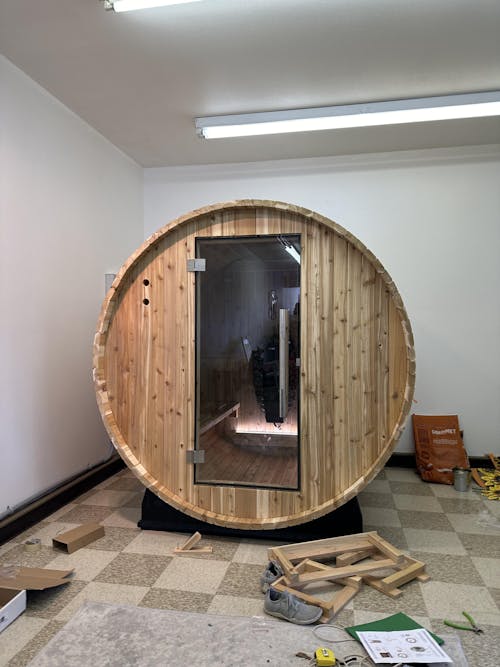
We ordered the 4 person barrel sauna and love it! We wanted a little extra space for the 2 of us/guests and it’s great. We could definitely fit 4 people in it if we needed. We use it every single day. It took about 10 weeks to get here because they build it specifically for the order. Putting the barrel together was fairly easy with 2 people. The electrical and the heater definitely required an electrician to install as we could have not done it alone.
We ordered the biggest heater (harvia spirit 8kw) and it heats up the sauna in about 15 mins inside our 40-50° garage. Overall this style of sauna is hotter and you sweat a lot faster than in an infrared sauna. I truly 10/10 recommend!
Pic is of us in the middle of building it.
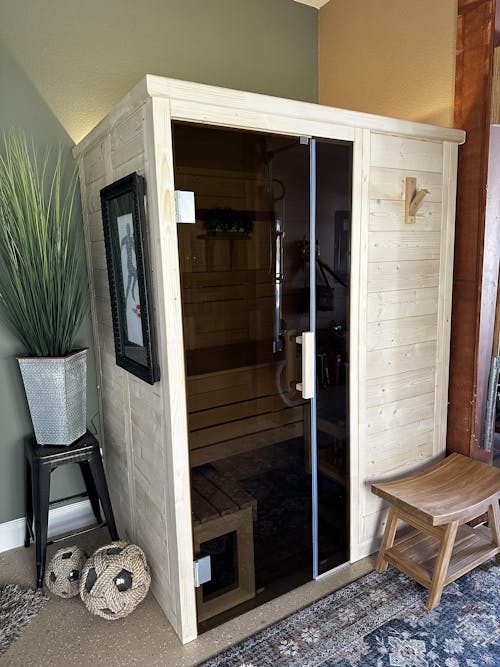
Took me about 6 hours over 2 evenings to assemble almost all by myself. Had a pro run a new circuit from my panel. Very well made and assembly was straightforward. Heater is well sized and reaches operating temperature in under 30 minutes.
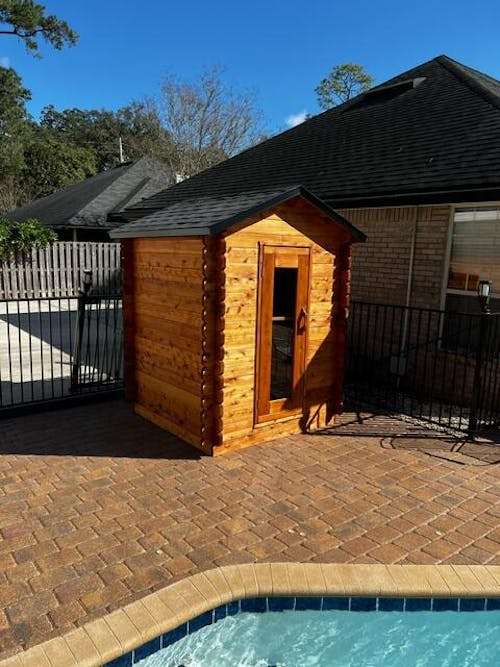
Great sauna very easy to assemble
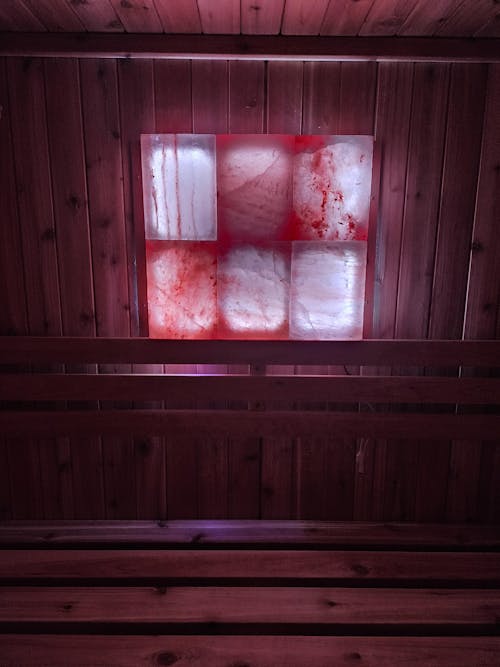
The salt panel was a great addition to our Madison Sauna. It has excellent grain which is accented by the amazing color lights that glow through the panel. Also when you hit the rocks with a splash of water you can feel the heat bounce off the panel. Great addition if you are considering this option.
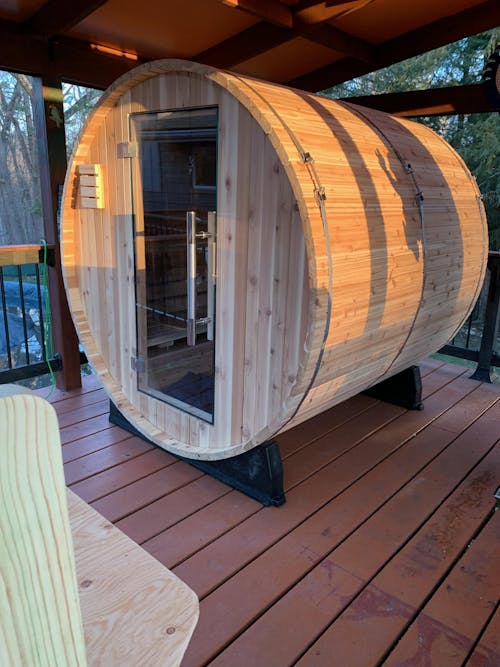
We can say enough about Sauna World there customer support is great! Our Pinnacle Sauna from Almost Heaven is epic.
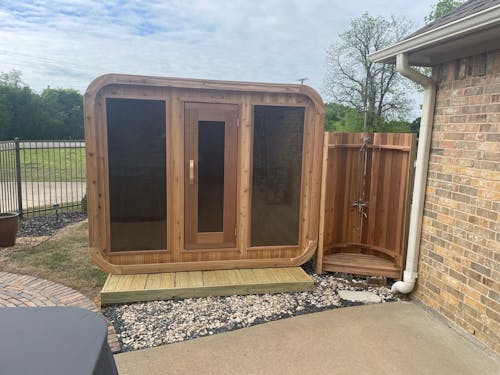
The finish and quality is outstanding and it was quick and easy to assemble.
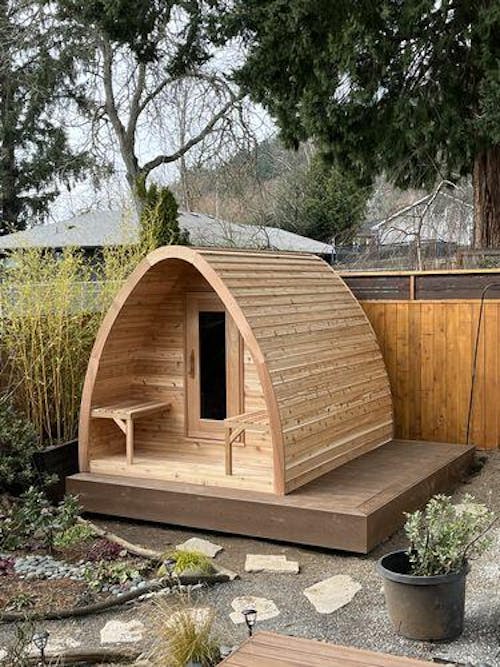
We are thrilled with our mini pod!! It came well shipped and our friend assembled it in 11 hours! Wow! We cannot wait to get healthy and sauna it up!
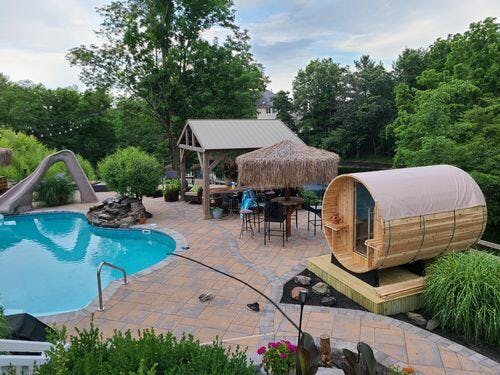
Beautiful sauna!!! Much easier than I expected to assemble, took a total of 4 hours. Can't wait to get warm by the pool on those cool evenings. Customer service was excellent..

Purchased a 2 person Almost Heaven barrel sauna and were delighted with the product. The order process was quick and easy, the sauna arrived on-time, installation was simple, following the provided instructions, and the sauna is extremely high quality. We’ve used it daily for over 2 weeks and quite frankly I don’t know how we lived without it. If I had it to do over again I wouldn’t change a thing... except maybe purchasing a 4 person model to easier share with friends!
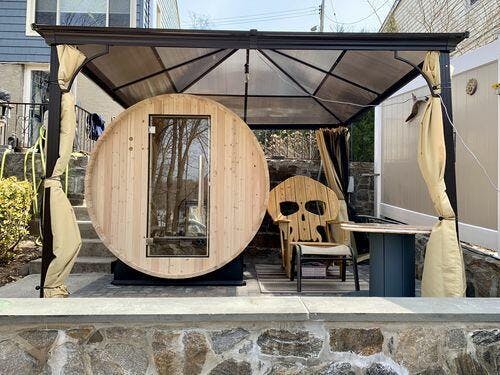
Great Customer Service and a breeze to put together.Excellent shipping and the Sauna is top notch, couldn’t be happier






























